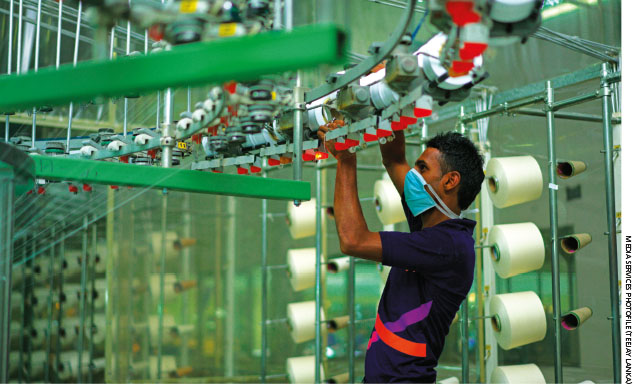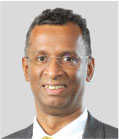SECTOR PERSPECTIVES
Textile Turnaround
Teejay Lanka capitalises on an evolving economy through agile innovation
Q: What changes have the textile and manufacturing industries experienced due to COVID-19?
A: The manufacturing industry is facing an unprecedented situation whereby predictions in the first quarter of 2020 no longer applied at the end of the year due to the rapid changes brought on by the pandemic.
 In short, there is no foolproof solution to the pandemic. Sri Lanka must adhere to health and safety protocols, and migrate to a new way of living, which is the norm that many developed countries have accepted.
In short, there is no foolproof solution to the pandemic. Sri Lanka must adhere to health and safety protocols, and migrate to a new way of living, which is the norm that many developed countries have accepted.
Moreover, many of these countries are proceeding with near full capacity economic activities under new guidelines, which is a positive indication for Sri Lanka’s manufacturing industry to also move ahead, as a permanent solution to the pandemic may not be feasible at least for the next 12 months or so.
As many customers are from the United States, we are more dependent on changes occurring in the US market, which has adapted to the changes much quicker than we have. This has resulted in business picking up momentum as orders have begun coming into Sri Lanka again.
Furthermore, lead times have become shorter, resulting in companies becoming more agile as brands increasingly move towards a ‘read and react’ model, where they read consumers and place orders for quick turnarounds.
Therefore, we must seek immediate solutions to be competitive, meet the demand and utilise maximum capacities.
Q: In the present context, how important are innovation and product development in textiles?
A: Quite simply, whatever the situation, innovation is key. A business must be sufficiently agile to respond quickly to changes in its environment – and transform itself from the usual pace of product development to innovate a new product that is more suitable to the requirements of the new environment.
 In the initial pandemic environment, Teejay and other textile manufacturers responded by creating technical textiles and products with antibacterial protection, as a result of the rising demand for personal protective equipment (PPE) during the first wave.
In the initial pandemic environment, Teejay and other textile manufacturers responded by creating technical textiles and products with antibacterial protection, as a result of the rising demand for personal protective equipment (PPE) during the first wave.
While this demand gradually subsided by midyear, we experienced a growing demand for our mainframe products – i.e. foundation garments, comfort wear and loungewear – as the global economy shifted and was impacted by the US-China trade war.
The world experienced a major shift in demand when China was severely impacted by COVID-19. To capitalise on this, Sri Lanka and other countries must be prepared to supply products in line with the volumes that are needed.
Moreover, textile manufacturers must work more closely with customers to understand their unique needs and expectations, to anticipate trends – and work with digital analysts to keep pace with rapidly evolving changes.
Sri Lanka should adopt swift measures to realign and redefine its strategies, to capitalise on the opportunities at hand and bring innovative product development to the forefront.
In the past, innovation was often viewed as leading to value additions or fashionable products. However, in the ‘new normal,’ more customers are seeking cost-effective products that are innovative. It is our responsibility to pursue cost-effective models and products that are competitive. In terms of showcasing new product developments and innovations, exhibitions and road shows have shifted online to various digital platforms. This is a change we must accustom ourselves to as a country.
Q: Are Sri Lankan textile companies doing enough to foray into new or emerging markets?
A: Sri Lanka has taken many possible actions within its capabilities – even during the pandemic – to reach new markets.
 Local textile manufacturers have duly followed all safety protocols and found innovative ways to restart operations. However, it remains to be seen if the measures taken are adequate in the long term.
Local textile manufacturers have duly followed all safety protocols and found innovative ways to restart operations. However, it remains to be seen if the measures taken are adequate in the long term.
With new control measures in place, Sri Lanka is experiencing many changes. It is possible that we may experience an overall drop in apparel output although the pace is on an upward trend again.
New market segments are opening up in Japan, Bangladesh, Africa and India. However, given our limitations in scale and infrastructure, we are also facing competition for these markets from Vietnam, Cambodia and similar manufacturing countries.
Q: What other lessons can Sri Lankan textile companies learn from their global counterparts?
 A: There is always something to learn, and textile companies are continuously on the lookout to improve each other’s innovations and master new skills.
A: There is always something to learn, and textile companies are continuously on the lookout to improve each other’s innovations and master new skills.
The US-China trade war proved that overdependence on a single supplier or country can be detrimental. This caused many to turn to local sourcing for raw materials. India and Bangladesh are scaling up their manufacturing and taking maximum advantage of the situation.
Therefore, it is advisable that Sri Lanka also makes use of this window of opportunity to scale up operations.
Given its geographical proximity to many major manufacturing locations, it is recommended that Sri Lanka rethinks strategies to improve its supply chain and production.




